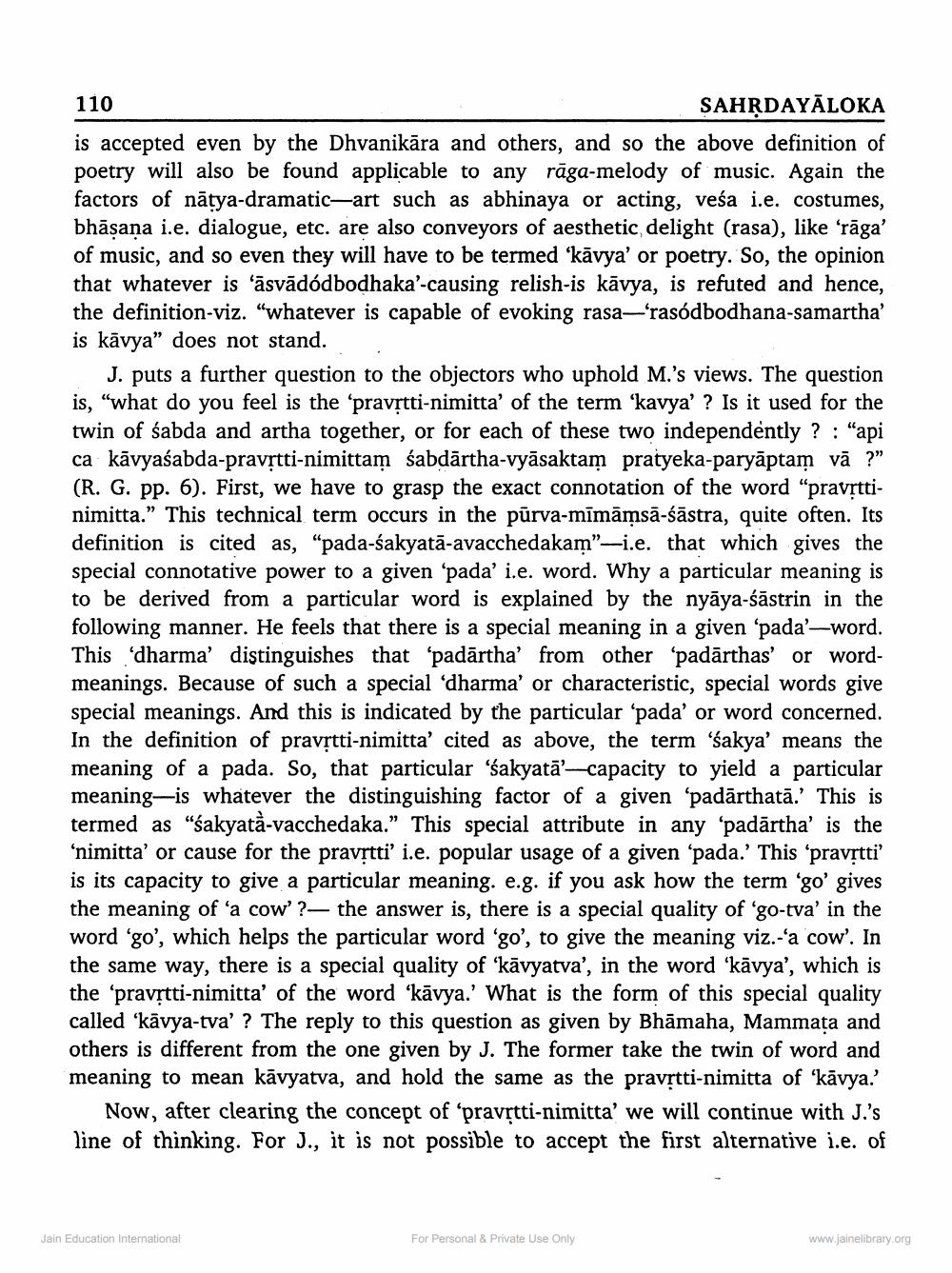________________
110
SAHĶDAYĀLOKA is accepted even by the Dhvanikāra and others, and so the above definition of poetry will also be found applicable to any rāga-melody of music. Again the factors of nātya-dramatic-art such as abhinaya or acting, veśa i.e. costumes, bhāsana i.e. dialogue, etc. are also conveyors of aesthetic delight (rasa), like 'rāga' of music, and so even they will have to be termed 'kāvya' or poetry. So, the opinion that whatever is 'āsvādódbodhaka'-causing relish-is kāvya, is refuted and hence, the definition-viz. "whatever is capable of evoking rasa—'rasódbodhana-samartha' is kāvya” does not stand.
J. puts a further question to the objectors who uphold M.'s views. The question is, “what do you feel is the 'pravstti-nimitta' of the term 'kavya'? Is it used for the twin of sabda and artha together, or for each of these two independently? : "api ca kāvyaśabda-pravrtti-nimittam sabdārtha-vyāsaktam pratyeka-paryāptam vā ?" (R. G. pp. 6). First, we have to grasp the exact connotation of the word “pravsttinimitta.” This technical term occurs in the pūrva-mīmāmsā-śāstra, quite often. Its definition is cited as, “pada-sakyatā-avacchedakam”-i.e. that which gives the special connotative power to a given 'pada' i.e. word. Why a particular meaning is to be derived from a particular word is explained by the nyāya-śāstrin in the following manner. He feels that there is a special meaning in a given 'pada'-word. This dharma' distinguishes that 'padārtha' from other 'padārthas' or wordmeanings. Because of such a special 'dharma' or characteristic, special words give special meanings. And this is indicated by the particular 'pada' or word concerned. In the definition of pravstti-nimitta' cited as above, the term 'sakya' means the meaning of a pada. So, that particular 'sakyatācapacity to yield a particular meaning-is whatever the distinguishing factor of a given 'padārthatā.' This is termed as "sakyată-vacchedaka.” This special attribute in any 'padārtha' is the ‘nimitta' or cause for the pravrtti' i.e. popular usage of a given ‘pada.' This ‘pravstti' is its capacity to give a particular meaning. e.g. if you ask how the term 'go' gives the meaning of 'a cow'?— the answer is, there is a special quality of 'go-tva' in the word 'go', which helps the particular word 'go', to give the meaning viz.-'a cow'. In the same way, there is a special quality of ‘kāvyatva', in the word 'kāvya', which is the 'pravstti-nimitta' of the word 'kāvya.' What is the form of this special quality called “kāvya-tva' ? The reply to this question as given by Bhāmaha, Mammața and others is different from the one given by J. The former take the twin of word and meaning to mean kāvyatva, and hold the same as the pravrtti-nimitta of 'kāvya.'
Now, after clearing the concept of 'pravrtti-nimitta' we will continue with J.'s line of thinking. For J., it is not possible to accept the first alternative i.e. of
Jain Education International
For Personal & Private Use Only
www.jainelibrary.org




